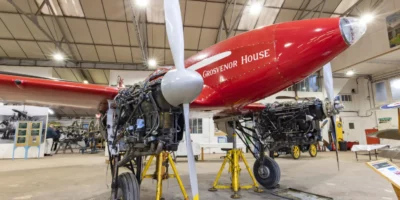Lockdown has certainly driven the desire to fill an ideal hangar, or garage, or kitchen… For me though, it’s an existing addiction… Once I’d learned to fly – or rather gained a licence which allowed me to continue learning – I swiftly tired of the mainstream, just as I had with cars. Utility was easy, the difficulty was divergence on a budget. Like a narcotic taking hold, the new parallel obsession sent me on familiar forays throughout Europe. I fetched a Cessna 195 from Finland, Wassmers from Germany and Denmark, several Bolkow 207s from Germany and a host of others. This was before the internet gained its influence, so it meant subscriptions to Flieger magazine, Aviasport, Aviation et Pilote and many more. And much writing of letters with the help of a dictionary, followed by many international phone calls.
“…so much water from a leaking roof that the fuselage had collapsed like so much papier-maché”
By the mid-1990s I had decided to make things more difficult with the desire to own either a Percival or a Miles, of which very few of either remained, let alone flew. An early trip to Upper Ballinderry near Lisburn in Northern Ireland was a taste of what would become a familiar experience. On May 22 1963, 37-year old photographer Thompson Boyes’ Miles Whitney Straight had suffered engine failure after leaving Enniskillen and force landed on a hilltop near Omagh. The aircraft nosed over in the boggy ground, tearing off the port undercarriage leg and breaking the propeller. The locals swiftly came to the rescue and removed the wings while a local garage fabricated a strut with two barrow wheels to replace the port leg. A lightly damaged Miles was towed tail first along the road to Newtownards, and then to the Ballinderry barn where Jim thoughtfully covered it with carpet to protect it from dust.
When I saw it nearly 30 years later, the carpet had gathered so much water from a leaking roof that the fuselage of a third surviving Whitney Straight had collapsed like papier-maché. Didn’t affect Jim’s idea of the aircraft’s worth, mind, which he saw somewhere north of £75K. Ah well, maybe a Percival Proctor then? I heard there was a Mk 3 stored near Southend. Closer to home and basically complete. “You’re late,” was the owner’s observation, “so I haven’t got time to show you the aeroplane…”
David, a friend and Typehound, found a Proctor 5 in a garden shed near Leicester. A bigger aeroplane which lacked the elegance of the earlier models, but still a Proctor nonetheless. A host of helpers toiled to extricate the kit of parts and carry it to the trailer waiting outside, which after several trips meant I did at last own a Proctor. It was soon clear though that the necessary complete restoration was beyond my modest skills, or more significantly, my budget. No matter, the enthusiasts for both marques remained especially zealous and offered a resource which I continued to access.
I’d heard of Miles Falcon F-BBCN, which had sat outside at Lognes near Paris for years, because there were photographs showing the Rallye sliding canopy which someone had fitted, and I knew it was owned by The Club Aerienne Les Gerfauts. The airfield had recently moved but the fact the aircraft was owned by a club was surely good news. There would be a committee who wouldn’t be able to agree on its destruction, so maybe it was sitting in a garage or a shed, just like the Proctor. Sometimes there was no choice but to get on a flight and do some face-to-face research, so armed with my best schoolboy French, I duly went to look and discovered that although the club still existed, nobody had any news of the Falcon’s whereabouts. No matter there was news of another one, sitting on top of a large metal pole as a landmark for a scrapyard in Aix en Provence. This time I managed to combine a visit with a press trip for a car launch which meant I could take one of my French colleagues whose command of his first language would surely be an advantage. Alas not…
There was a Falcon four in Australia which the owner wasn’t interested in selling, and the remains of a Vega Gull – the Proctor’s civilian forbear – which was again too much of a project for me. I then heard of another Proctor 5 which was apparently complete, stored in a shed at a microlight strip only a few miles from my home. When I eventually tracked down the owner, he confirmed that yes he still had a Proctor, and that he had taken the remains with him when he emigrated to Australia…
Thirty years on and the Proctor 5 G-AKIU, which I dragged out of Leicestershire, is the only one airworthy – although there are several under restoration – and G-AERV, the bedraggled Whitney Straight is also the only one flying. Just not with me at their controls…
I never did own a flyable Proctor, but a long journey eventually led to ownership of not one, but two Mileses. A silver Gemini, which gave me equal amounts of delight and frustration for many years, and now a Messenger which resolutely maintains both emotions…
Working vintage aircraft and cars make Mark particularly happy.
[email protected]







